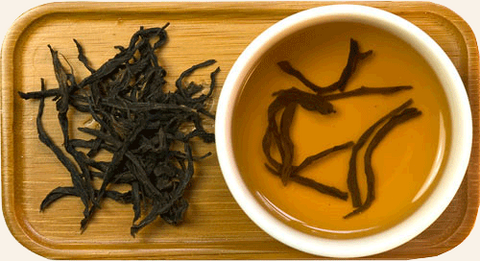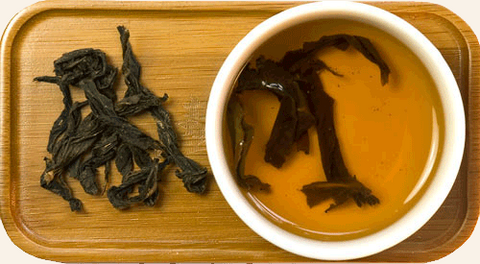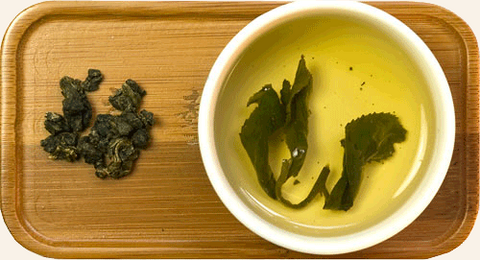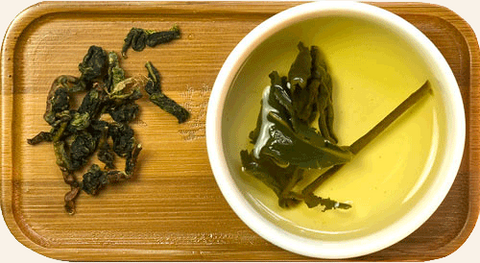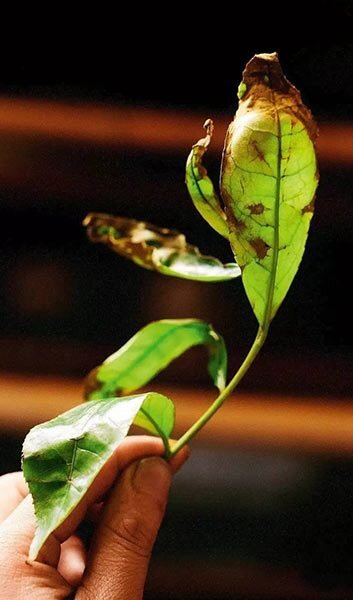This is how the legend on appearance of oolongs tells it.
In one village there lived a tea maker named Wu Long (Black Dragon). The neighbors called him so because he was strong as a dragon (Long) and very dark-skinned (Wu). To make his living the tea maker also had to hunt. One day with his basket and shot-gun Wu Long went to the forest.
The whole morning he was gathering tea leaves but in the afternoon he noticed a deer on the path and followed him. He spent the rest of the day chasing his prey, running across forest creeks and over hills, and late at night finally came back to his house with a trophy. All his family got busy skinning the dear and nobody bothered to take care of the tea leaves. Only in the morning Wu Long rushed to the leaves and saw that they are spoiled: broken and covered with dark spots. However the odor shed from the basket was rich and floral. As it often happens the tea maker decided to roast the tea and was amused to find out that resulting tea was very fragrant. He brewed the tea like he had never tasted before!
All relatives and neighbors were invited to try this wondrous beverage. They became curious where he had found such splendid and fragrant leaves. The tea maker recalled that he had been gathering tea in the same places as usual so it was not about the leaves. Then Wu Long realized: the tea became extraordinary because for several hours it was tossed in the basket, the leaves broke, bled sap and changed overnight. All the family joined their effort to replicate such transformation of the leaf. Step by step, by trial and error new production technology of oolongs, as we know them today, has been consistently elaborated.
Tea experts consider that modern oolong production technology has been established in the beginning of 17th century. It originates from North Fujian therefore first oolongs were produced in Wuyi mountains. Gradually it was adapted in Guangdong and in South Fujian. Yet each region adduces own arguments in this dispute. To Taiwan both oolong plants and production technology arrived only in 19th century.
Oolongs are classified as semi-fermented tea, which means that the leaf is oxidized unevenly. The specific feature of production consists in the unique processing of the leaf, which in China is referred to as «Hong Bian Lu Ye» (red rim, green leaf). But in order to produce decent oolong the leaf itself should carry bright fruity or floral aroma. Processing merely intensifies this feature and makes it richer.
Fermentation of «black» oolongs ranges from 30% to 70%. By flavor and effect they approximate to red tea. This is most traditional type of oolongs. In old times, before refrigerators and airplanes were invented, strong roasting enabled better retention of tea flavor in long distance transportation. Therewith an experienced tea maker by means of roasting may add most balanced flavor to a tea. But this is not an easy thing to do: incompetent craftsman may spoil even the best leaf. This method is used for production of North Fujian, Guangdong oolongs and traditional Tieguanyin.
So called «green» oolongs are fermented up to 30%. By taste they are notably closer to green teas. They frequently retain the feeling of freshness, with basic flavor of grass and flowers, and easily sensible hints of fruit — papaya, kiwi, orange. These oolongs are easily recognizable by blue and green color of the leaf, in China frequently referred to as Qingcha (青茶), which translates as «turquoise tea». This tea is largely produced in Taiwan (which made it trendy).However old good Tieguanyin over the recent 50 years tends to be slightly fermented and roasted as well. Light roasting in the first instance is valued for unveiling the natural flavor of the tea leaf, unlike strongly roasted oolongs where flavor in large part depends on the skills of a tea maker.
I will take a detailed look at each of four production regions.

